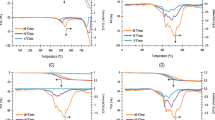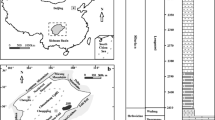Abstract
The increase in global energy demand has stimulated the development of unconventional and deepwater reservoirs such as shale-gas formations, which have become a primary energy source in recent years. Complex technological challenges are involved in the successful exploration and exploitation of shale gas reservoirs. Thermal analysis of shales can provide key knowledge on their mineral composition, reaction mechanisms, kinetic parameters, thermal stability and reactivity, which are very useful to improve the characterization of shale-gas reservoirs. This work presents an investigation about the thermal behavior of a shale sample extracted from a Mexican deepwater gas field. X-ray diffraction (XRD) was used to characterize the shale mineralogy revealing a complex composition of mainly quartz, carbonates, and clays. Non-isothermal pyrolysis tests were performed through simultaneous differential scanning calorimetry (DSC) and thermogravimetric (TG) analysis to characterize the shale thermal-behavior in a temperature range from ambient to 900 °C. Scanning electron microscopy (SEM) was used to characterize the shale morphology before and after pyrolysis. Iso-conversional methods were used to obtain the kinetic parameters, whereas Coats–Redfern (CR) and master-plot methods were used to find the most probable reaction mechanisms involved in the shale pyrolysis. Reactivity of the shale in presence of saline solutions as shale stabilizers was evaluated by using TG-DSC tests. Results showed that shale pyrolysis is carried out in two stages: a clays dehydroxylation following a three-dimensional diffusion mechanism with an average activation energy of 243.58 kJ/mol, and a carbonates decomposition described through a one-dimensional diffusion mechanism with an average activation energy of 220.43 kJ/mol.

(Source: Google Earth)










Similar content being viewed by others
References
Wang, S.; Qin, C.; Feng, Q.; Javadpour, F.; Rui, Z.: A framework for predicting the production performance of unconventional resources using deep learning. Appl. Energy 295, 117016 (2021)
Middleton, R.S.; Gupta, R.; Hyman, J.D.; Viswanathan, H.S.: The shale gas revolution: barriers, sustainability, and emerging opportunities. Appl. Energy 199, 88–95 (2017)
Lal, M.: Shale stability: drilling fluid interaction and shale strength. In: SPE Latin American and Caribbean Petroleum Engineering Conference held in Caracas, Venezuela (1999). https://doi.org/10.2118/54356-MS
Wan, Y.; Chen, Z.; Shen, W.; Kuang, Z.; Liu, X.; Guo, W.; & Hu, Y.: Study of the effects of hydraulic fractures on gas and water flow in shale gas reservoirs. Energy Sources Part A: Recovery Util. Environ. Effects 1–12 (2019)
Striolo, A.; Cole, D.R.: Understanding shale gas: recent progress and remaining challenges. Energy Fuels 31(10), 10300–10310 (2017)
Zou, C.; Zhao, Q.; Dong, D.; Yang, Z.; Qiu, Z.; Liang, F.; Hu, Z.: Geological characteristics, main challenges and future prospect of shale gas. J. Natl. Gas Geosci. 2(5–6), 273–288 (2017)
Lyu, Q.; Ranjith, P.G.; Long, X.; Kang, Y.; Huang, M.: A review of shale swelling by water adsorption. J. Natl. Gas Sci. Eng. 27, 1421–1431 (2015). https://doi.org/10.1016/j.jngse.2015.10.004
Anderson, R.L.; Ratcliffe, I.; Greenwell, H.C.; Williams, P.A.; Cliffe, S.; Coveney, P.V.: Clay swelling—a challenge in the oilfeld. Earth-Sci. Rev. 98, 201–216 (2010). https://doi.org/10.1016/j.earscirev.2009.11.003
Al-Bazali, T.M.; Zhang, J.; Chenevert, M.E.; Sharma, M.M.: An experimental investigation on the impact of diffusion osmosis, chemical osmosis and capillary suction on shale alteration. J. Porous Media 11(8), 719–731 (2008). https://doi.org/10.1615/JPorMedia.v11.i8.20
Van Oort, E.: On the physical and chemical stability of shales. J. Petrol. Sci. Eng. 38, 213–235 (2003). https://doi.org/10.1016/S0920-4105(03)00034-2
Faruk, C.: Mechanism of Clay Swelling from Reservoir Formation Damage—Fundamentals, Modeling, Assessment, and Mitigation. Elsevier, Houston (2000)
de Carvalho, B.R.; Vidal, E.L.F.; Borges, M.R.: Design of experiments to evaluate clay swelling inhibition by different combinations of organic compounds and inorganic salts for application in water base drilling fluids. Appl. Clay Sci. 105, 124–130 (2015). https://doi.org/10.1016/j.clay.2014.12.029
Alcázar-Vara, L.A.; Cortés-Monroy, I.R.: Drilling fluids for deepwater fields: an overview. Recent Insights Pet. Sci. Eng. (2018). https://doi.org/10.5772/intechopen.70093
Gholami, R.; Elochukwu, H.; Fakhari, N.; Sarmadivaleh, M.: A review on borehole instability in active shale formations: Interactions, mechanisms and inhibitors. Earth Sci. Rev. 177, 2–13 (2018). https://doi.org/10.1016/j.earscirev.2017.11.002
Testamanti, M.N.; Rezaee, R.: Determination of NMR T2 cut-off for clay bound water in shales: a case study of Carynginia Formation, Perth Basin, Western Australia. J. Petrol. Sci. Eng. 149, 497–503 (2017)
Wang, H.; Rezaee, R.; Saeedi, A.: Preliminary study of improving reservoir quality of tight gas sands in the near wellbore region by microwave heating. J. Natl. Gas Sci. Eng. V 32, 395–406 (2016). https://doi.org/10.1016/j.jngse.2016.04.041
Liu, P.; Wang, X.; Meng, Q.; Wang, X.; Zhang, L.; Liu, C.; Lei, Y.; Jiang, Ch.; Yin, J.: Simulation of shale gas generation by using different experimental systems: a case study from Chang7 shale in the Ordos Basin. J. Nat. Gas Sci. Eng. 49, 169–178 (2018). https://doi.org/10.1016/j.jngse.2017.10.017
Brown, M.E.; Maciejewski, M.; Vyazovkin, S.; Nomen, R.; Sempere, J.; Burnham, A.; Opfermann, J.; Strey, R.; Anderson, H.L.; Kemmler, A.; Keuleers, R.; Janssens, J.; Desseyn, H.O.; Keuleers, R.: Computational aspects of kinetic analysis: part A: the ICTAC kinetics project-data, methods and results. Thermochim. Acta 355(1–2), 125–143 (2000). https://doi.org/10.1016/S0040-6031(00)00443-3
Wang, H.; Ajao, O.; Economides, M.J.: Conceptual study of thermal stimulation in shale gas formations. J. Natl. Gas Sci. Eng. 21, 874–885 (2014)
Santos, H.D.; Gupta, A.: Application of thermal analysis to characterize clay-rich formations. In: Technical Meeting/Petroleum Conference of the South Saskatchewan Section. Petroleum Society of Canada (1997). https://doi.org/10.2118/97-189
Chen, G.; Yan, J.; Lili, L.; Zhang, J.; Gu, X.; Song, H.: Preparation and performance of amine-tartaric salt as potential clay swelling inhibitor. Appl. Clay Sci. 138, 12–16 (2017)
Bouamoud, R.; Moine, E.C.; Mulongo-Masamba, R.; El Hamidi, A.; Halim, M.; Arsalane, S.: Type I kerogen-rich oil shale from the Democratic Republic of the Congo: mineralogical description and pyrolysis kinetics. Pet. Sci. 17(1), 255–267 (2020)
Zhang, J.; Ding, Y.; Du, W.; Lu, K.; Sun, L.: Study on pyrolysis kinetics and reaction mechanism of Beizao oil shale. Fuel 296, 120696 (2021)
Braun, R.L.; Burnham, A.K.; Reynolds, J.G.; Clarkson, J.E.: Pyrolysis kinetics for lacustrine and marine source rocks by programmed micropyrolysis. Energy Fuels 5, 192–204 (1991). https://doi.org/10.1021/ef00025a033
PEMEX Business Plan 2019–2023
Srodon, J.; Drits, V.A.; McCarty, D.K.; Hsieh, J.C.; Eberl, D.D.: Quantitative X-ray diffraction analysis of clay-bearing rocks from random preparations. Clays Clay Miner. 49(6), 514–528 (2001). https://doi.org/10.1346/CCMN.2001.0490604
Reed, S.J.B.: Electron Microprobe Analysis and Scanning Electron Microscopy in Geology. Cambridge University Press, Cambridge (2005)
Vyazovkin, S.; Burnham, A.K.; Criado, J.M.; Pérez-Maqueda, L.A.; Popescu, C.; Sbirrazzuoli, N.: ICTAC Kinetics Committee recommendations for performing kinetic computations on thermal analysis data. Thermochim. Acta 520, 1–19 (2011). https://doi.org/10.1016/j.tca.2011.03.034
Coats, A.W.; Redfern, J.P.: Kinetic parameters from thermogravimetric data. Nature 201(4914), 68–69 (1964). https://doi.org/10.1038/201068a0
Jankovic, B.: Kinetic analysis of the nonisothermal decomposition of potassium metabisulfite using the model-fitting and isoconversional (model-free) methods. Chem. Eng. J. 139, 128–135 (2008). https://doi.org/10.1016/j.cej.2007.07.085
Doyle, C.D.: Estimating isothermal life from thermogravimetric data. J. Appl. Polym. Sci. 6, 639–642 (1962). https://doi.org/10.1002/app.1962.070062406
Huang, C.; Zhang, J.; Hua, W.; Yue, J.; Lu, Y.: Sedimentology and lithofacies of lacustrine shale: a case study from the Dongpu sag, Bohai Bay Basin, Eastern China. J. Nal. Gas Sci. Eng. 60, 174–189 (2018). https://doi.org/10.1016/j.jngse.2018.10.014
Santos, H.; Rego, L.F.B.; da Fontoura, S.A.B.: Integrated study of shale stability in deepwater, Brazil. In: Latin American and Caribbean Petroleum Engineering Conference. Society of Petroleum Engineers (1997). https://doi.org/10.2118/38961-MS
Yang, F.; Ning, Z.; Liu, H.: Fractal characteristics of shales from a shale gas reservoir in the Sichuan Basin, China. Fuel 115, 378–384 (2014). https://doi.org/10.1016/j.fuel.2013.07.040
Chen, W.; Lei, Y.; Chen, Y.; Sun, J.: Pyrolysis and combustion enhance recovery of gas for two China shale rocks. Energy Fuels 30, 10298–10305 (2016). https://doi.org/10.1021/acs.energyfuels.6b02274
Santos, H.M.R.: A new conceptual approach to shale stability. Ph.D. Thesis, University of Oaklahoma (1997)
Brown, M.E.; Gallagher, P.K.: Handbook of Thermal Analysis and Calorimetry Volume 2. Applications to Inorganic and Miscellaneous Materials Handbook of Thermal Analysis and Calorimetry. Elsevier, Amsterdam (2003)
Gips, J.P.; Daigle, H.; Sharma, M.: Characterization of free and bound fluids in hydrocarbon bearing shales using NMR and Py GC-ms. In: Unconventional Resources Technology Conference, Denver, Colorado, 25–27 August 2014 (pp. 1217–1225). Society of Exploration Geophysicists, American Association of Petroleum Geologists, Society of Petroleum Engineers (2014). https://doi.org/10.15530/urtec-2014-1917686
Chen, S.; Han, Y.; Fu, C.; Zhang, H.; Zhu, Y.; Zuo, Z.: Micro and nano-size pores of clay minerals in shale reservoirs: implication for the accumulation of shale gas. Sed. Geol. 342, 180–190 (2016). https://doi.org/10.1016/j.sedgeo.2016.06.022
Wilson, M.J.; Wilson, L.: Clay mineralogy and shale instability: an alternative conceptual analysis. Clay Miner. 49(2), 127–145 (2014). https://doi.org/10.1180/claymin.2014.049.2.01
Lee, S.; Fischer, T.B.; Stokes, M.R.; Klingler, R.J.; Ilavsky, J.; McCarty, D.K.; Wigand, M.O.; Derkowski, A.; Winans, R.E.: Dehydration effect on the pore size, porosity, and fractal parameters of shale rocks: Ultrasmall-angle X-ray scattering study. Energy Fuels 28(11), 6772–6779 (2014). https://doi.org/10.1021/ef501427d
Ondro, T.; Al-Shantir, O.; Obert, F.; Trník, A.: Non-isothermal kinetic analysis of illite dehydroxylation. In: AIP Conference Proceedings (Vol. 2133, No. 1, p. 020036). AIP Publishing LLC (2019). https://doi.org/10.1063/1.5120166
Maciejewski, M.: Computational aspects of kinetic analysis: Part B: The ICTAC Kinetics Project—the decomposition kinetics of calcium carbonate revisited, or some tips on survival in the kinetic minefield. Thermochim. Acta 355(1–2), 145–154 (2000). https://doi.org/10.1016/S0040-6031(00)00444-5
Maitra, S.; Bandyopadhyay, N.; Das, S.; Pal, A.J.; Pramanik, J.: Non-isothermal decomposition kinetics of alkaline earth metal carbonates. J. Am. Ceram. Soc. 90, 1299–1303 (2007). https://doi.org/10.1111/j.1551-2916.2007.01607.x
O’Brien, D.E.; Chenevert, M.E.: Stabilizing sensitive shales with inhibited potassium-based drilling fluids. J. Pet. Technol. (1973). https://doi.org/10.2118/4232-PA
Al-Bazali, T.M.: The consequences of using concentrated salt solutions for mitigating wellbore instability in shales. J. Petrol. Sci. Eng. 80(1), 94–101 (2011). https://doi.org/10.1016/j.petrol.2011
Acknowledgements
The authors express gratitude to the Instituto Mexicano del Petróleo (IMP) for both providing facilities and granting permission to publish results. This work was supported by the IMP and Sectorial Fund SENER (Secretary of Energy)-CONACyT (National Council of Science and Technology in Mexico)-Hydrocarbons through the “Center of Technology for Deep Water (CTAP)” project. Guerrero-Hernández J. thanks both UNAM and CONACYT for the financial support granted during her Master of Engineering Studies.
Author information
Authors and Affiliations
Corresponding author
Ethics declarations
Conflict of interests
The authors declare that they have no conflict of interests.
Rights and permissions
About this article
Cite this article
Alcázar-Vara, L.A., Guerrero-Hernández, J. & Cortés-Monroy, I.R. Thermal Analysis of Shale from a Mexican Deepwater Gas Field. Arab J Sci Eng 47, 7335–7349 (2022). https://doi.org/10.1007/s13369-021-06281-4
Received:
Accepted:
Published:
Issue Date:
DOI: https://doi.org/10.1007/s13369-021-06281-4




